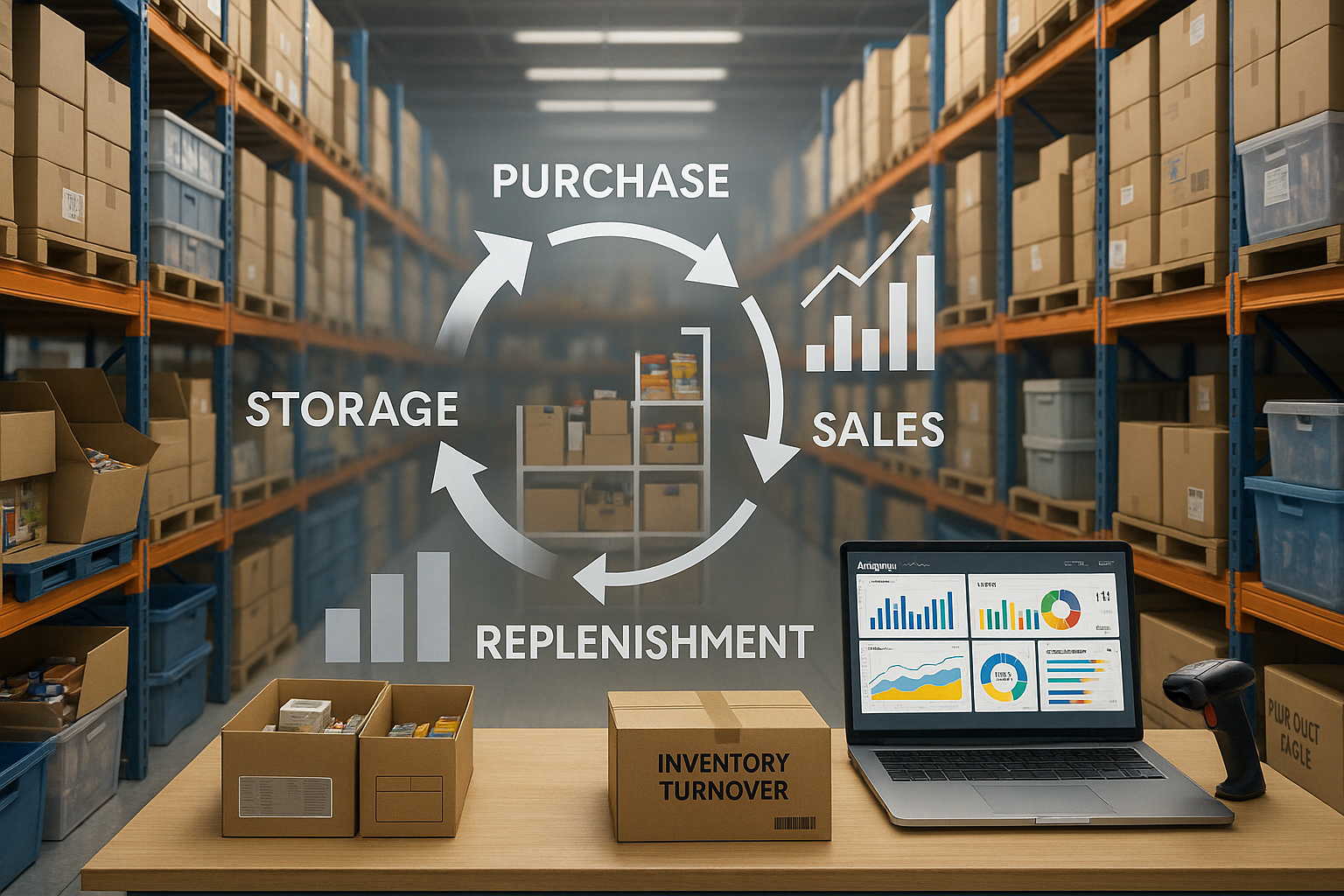How to Choose the Right Inventory Management System

The approach of retail chains to inventory management has changed significantly over the past few years. This transformation is not just about automating this function but also about raising awareness among retailers. There is now a clear understanding of why inventory management is important and what they specifically want from an inventory management system.
Looking back at the market seven years ago, most chains had decentralized purchasing, and there was no mention of a specialized tool. There was neither methodology in inventory management nor specialized instruments. Now, the situation is quite the opposite, and the number of chains using such an outdated approach is steadily decreasing.
Retail chains are reducing the influence of human decision-making on the quantity of ordered goods.
The reasons for this are as follows:
On-site staff may have a financial interest in purchasing certain products.
Individual employee KPIs may differ from the KPIs used in inventory management.
A clear example of this is when operational staff are motivated to minimize write-offs. In this case, categories that are prone to write-offs are ordered with particular caution, often with shortages and definitely not in excess. If the motivation is tied to sales, issues arise with ordering products that are part of the assortment matrix but sell poorly. As a result, the execution of the assortment matrix becomes inaccurate, leading to distorted overall information about product movement.
All these factors have contributed to the active development of the inventory management systems market. Their key value lies in the fact that the system generates orders on behalf of the user.
Before the advent of such tools, retailers processed information in Excel files. They were eventually replaced by built-in modules in ERP systems, but these typically contained simplified min/max algorithms and did not allow for a tailored approach for different types of SKUs, especially in an automated mode without human intervention. This again led to the use of good old Excel as an assistant. Employees had to make decisions and approve the order quantities that the system suggested.
In reality, it was just sales statistics that allowed individuals to indicate how much product needed to be ordered based on this data and their own opinion. Making decisions for each SKU took a lot of time and energy and was inefficient. Now, specialized solutions perform this routine function. They allow different algorithms to be applied to different product categories and take into account a vast number of factors affecting demand. It sounds like a magic bullet for the purchasing department, doesn’t it?
However, it’s important to understand that no matter what system you choose, without properly configured business processes within the company, you will not see an improvement in financial performance.
The effectiveness of a retail company, in financial terms, is determined by the negative cash cycle and its magnitude. The larger the difference between the payment delay to suppliers and the inventory turnover, the more operational funds are available for the development of the network.
Payment terms are not only a matter of the market power of the network but also reflect the negotiation skills of category managers. Meanwhile, inventory turnover is a key balancing indicator of inventory efficiency. The calculation of turnover involves stock and sales over a specific period, indicating how many days of sales the current inventory will cover. The effectiveness of the assortment matrix and the inventory management system play a crucial role in determining how good this indicator will be.
In a broad sense, an inventory management system comprises a set of business processes within a retail company aimed at achieving a certain level of availability of the assortment matrix for customers in the store. These business processes include:
- replenishment of stores and central warehouse stocks of both regular and promotional goods, seasonal assortment (taking into account all limitations of own SC and suppliers);
- analyzing key performance indicators of inventory;
- responding to emerging problems;
- “what-if” analysis, which allows modeling key performance indicators when changing incoming parameters. Let’s represent a retail company consisting of 30 stores with an average assortment of 5000 SKU. The number of management objects to replenish the inventory is equal to 150,000, each of which has its own demand dynamics, supply features, category affiliation. Each of these goods requires separate attention, calculation logic and analysis. This explains the need for an automated inventory management system that does all the calculations “under the hood”. The user in this paradigm becomes a manager, managing constraints and working with KPIs and their improvements.
What is important to pay attention to when auditing an existing or choosing a new inventory management system?
An inventory management system should perform the following tasks:
- Accurately calculate the target inventory and order quantity for each SKU at every storage location within the retail network.
- Be able to prepare in advance for organized fluctuations in demand, such as promotional campaigns, as well as seasonal and holiday sales peaks.
- Provide line managers and company management with analytics on key performance indicators for inventory management.

To accomplish these tasks, the inventory management system must meet the following requirements:
1. High Level of Automation & Quality UI/UX.
The inventory management system should identify the user’s tasks for the day and prioritize them. As a result, the employee should always have a clear understanding of the current status of the items they are responsible for, including excess stock, shortages, deliveries, and delayed orders, etc.
Additionally, they should receive alerts about actual and potential errors that they may have overlooked, aided by prompts in the interface.
An intuitive interface is the foundation for the efficient operation of its users. Remember, the system should not only automate all routine functions but also allow employees of any skill level to quickly understand how to work with it.
2.The System’s Ability to Influence Key Financial Metrics of the Company
This is made possible through:
- Automated calculation of the necessary stock levels for each SKU/location and the automatic updating of this figure in response to changes in demand, supply parameters, changes in supplier packaging, and other factors.
- Automated generation and dispatch of movements within the supply chain, as well as supplier orders from both stores and warehouses, and cross-docking orders.
- Algorithms for store orders, warehouse orders considering the needs of the network and warehouse sales, orders for non-regular demand items, perishable goods, seasonality, and promotions.
The factors that need to be considered in the algorithms for different categories of products vary.
For Fresh category products, in addition to the above, it is essential to consider: demand variation within the week, target shelf availability, and remaining shelf life.
The inventory management system must account for all these factors and allow the retailer to customize the algorithms to suit the specifics of their business.
When generating orders for the central warehouse, the algorithms should consider:
- All parameters of the stores and demand at the stores;
- Promotions at the stores;
- Seasonality;
- Warehouse sales (if applicable);
- Other factors that may occur at the stores during the supply lead time of the next order to the warehouse.
3. Additional Functionality When Formulating Orders
- Optimization of orders by total amount, weight, pallets, and quantity. This can occur both upwards and downwards. Upwards—if there is a supplier constraint on the minimum amount, and downwards—if there is a budget limitation and no possibility to send an order above a certain amount.
- Splitting orders according to the capacity/volume of transport vehicles.
- Consideration of alternative products when generating orders (products that are simultaneously present in the assortment matrix).
- Consideration of substitute products (one product substitutes another, or only one of them is present in the assortment matrix, which is irrelevant to the network customer).
- The possibility of accounting for alternative suppliers.
4. Management of Promotions and Seasonality
- Automatic recalculation of inventory levels to prepare for the end of promotions/seasons.
- Automatic consideration of seasonality coefficients.
- Depending on the network/category of goods, the system should account for seasonality coefficients broken down by months and weeks.
- Consideration of public holidays and deviations in orders. This is an important aspect that helps avoid financial losses when a supplier cannot fulfill an order for several days or some period. The inventory management system should allow you to prepare for such situations and have the ability to refrain from placing orders during that time.
- Automatic calculation of the quantity of goods for promotions and the timing of when these goods should be in the store (preparation for promotions).
- The ability to flexibly add and remove items from promotions (if necessary from the perspective of business processes within the retail company).
- Automatic recalculation of demand based on current promotional sales.
- Consideration of promotional DMP (additional supplier locations) of various types.
- The system should have the capability to properly exit promotions. The functionality should allow for conducting both sales and promotions for in-out goods, as well as regular promotions with different mechanics.
- Visual representation (provides a clear understanding and allows for analysis of when and for which products promotions occurred in the past).
5. Performance Indicators and Deviations Alerts
- Displaying the overall situation regarding key indicators: out-of-stock, overstock, inventory turnover, availability, inventory cost, and sales dynamics.
- Indication of tasks that require attention, such as deteriorating availability for promotional goods.
6. Data Control and Transparency
- The ability to quickly generate a list of items with shortages or excess inventory at any time, and to view the history of orders and movements of each item in the warehouse for timely situation analysis.
- Logging of changes made by users in the system.
7. Analytics Block
- Flexible reporting for analyzing lost sales, excess inventory, availability, and turnover across warehouses, managers, and product groups.
- Reports on the timeliness and quality of order fulfillment by suppliers.
- Availability and turnover performance reports.
- Reports for comparing like-for-like metrics.
- The ability to analyze items in the Fresh category, items that are currently on promotion, or items that have recently completed a promotion.
- The ability to analyze the changes made by users in the system and the reasons for those changes.
8. Cross-Platform Compatibility & Flexibility
- The ability to log into the system from any device and from anywhere in the world.
- Flexibility in settings — a must-have! To ensure the system aligns with the client’s business processes, its settings should allow for quick adaptation to specific requests. Modifications to hard code can be more expensive and take much longer, so pay special attention to this!
- The ability to integrate with any accounting system.
- High speed of system operation.
9. Ongoing Technical and Consulting Support from the System Provider
In summary, when choosing an inventory management system, pay attention to:
- The algorithms for inventory replenishment and their adaptability to changing market conditions.
- The user-friendliness of the interface with which people interact.
- The ability to consider the specifics of your company’s business processes.
- The ability to quickly obtain a transparent view of KPIs.
- The notification system that alerts managers to current or potential issues with inventory.
Meeting these requirements has become an industry standard, especially in developed countries. Nevertheless, the importance of having the right tool to automate such a critical process cannot be underestimated, as it underpins the financial effectiveness of any retail company. Therefore, determine whether your inventory management system meets industry standards or if there are areas that require optimization. These areas could become growth zones for your network’s profits.
At the core of software solutions lies different methodologies; the greatest effect comes from combining pull and forecasting practices, where each yields the best results. This approach is embedded in the ABM Inventory system. It enhances turnover, promotes sales growth, and creates transparency in inventory management.


